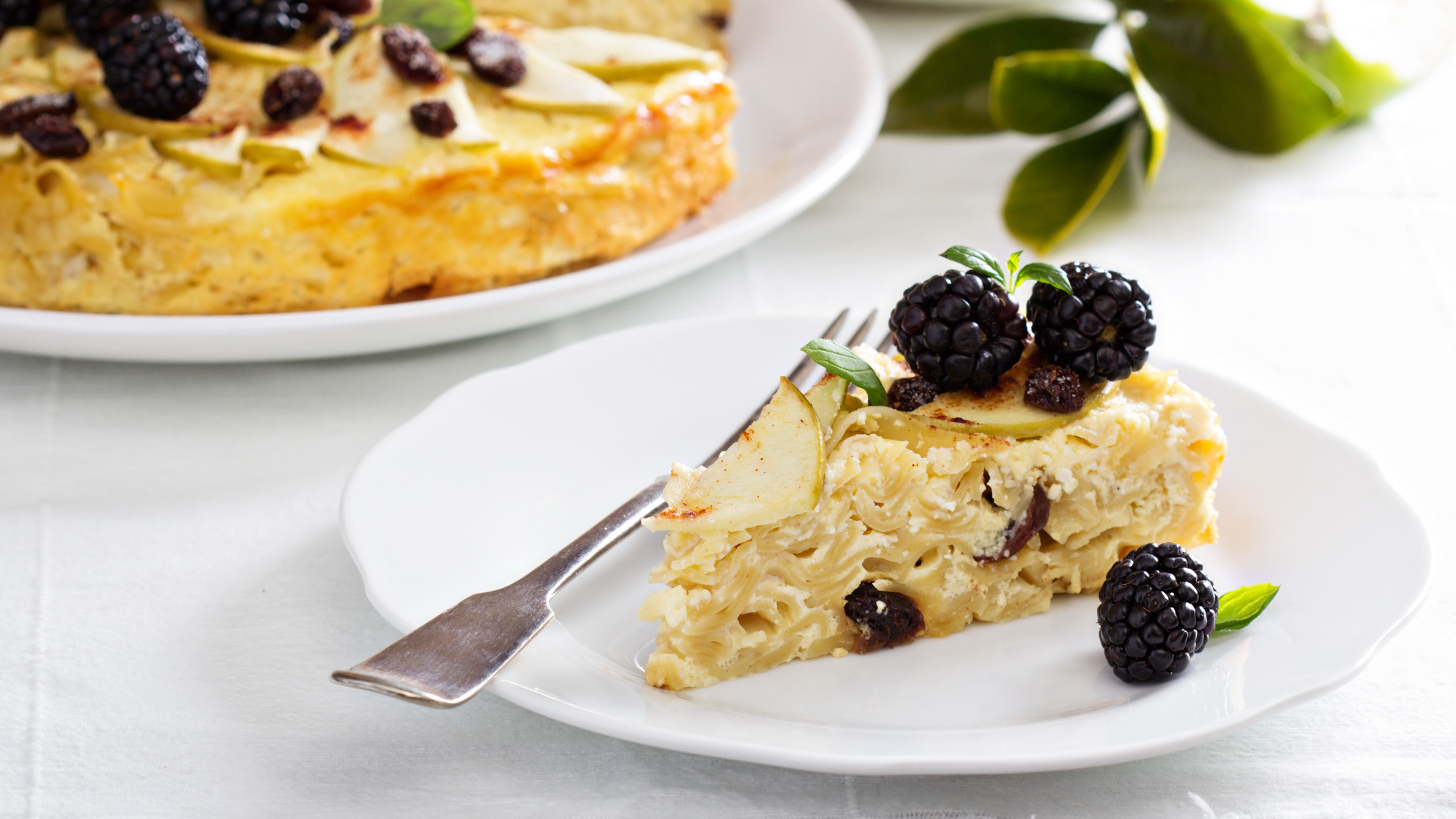How To Make My Noodle Kugel, A Glorified Pasta Cheesecake
I have committed terrible crimes against my digestive system. As a broke, recent college graduate living during the height of the recession, I once purchased a grocery store cookie cake that said, "Happy Birthday Gary" on it. I ate chunks of that cake for breakfast everyday for a week, while feeling terrible that Gary never got to eat his birthday treat. In fifth grade, I brought a tuna sandwich and banana to school every day and wondered why no one wanted to sit near me during lunch. For almost 25 years, I was convinced that peppers were bad.
When it comes to my food choices, I have infinite regrets.
But at the exact opposite end of that spectrum, one of the few food-related regrets I don't have is teaching myself to make my Aunt Lynne's noodle kugel. Kugel (rhymes with bugle) is the Ashkenazi take on a pudding dish, the Jewish equivalent of a green bean casserole. Kugel is the German word for "sphere" and German Jews would create savory puddings by filling their round baking dishes full of stew and dough made from flour and water.
The dish evolved in the 800 years since, with cooks replacing the dough with noodles to enhance the pudding's flavor and texture. Today, kugel comes in both sweet and savory varieties, and the formula for creating it usually involves some combination of eggs, starch, and fat. It's an adaptable dish, easily modified to fit any number of dietary restrictions and food-related preferences. And like most casseroles, it can be prepared ahead of time, making it an easy choice for every occasion, from high holiday dinners to hangover brunches.
Of all the kugel variations, "Loshken" (Yiddish for noodle) is my favorite. It's what would happen if you replaced the bread in bread pudding with pasta and added considerably more dairy. It's baked macaroni and cheese, if instead of a creamy cheddar sauce, you substituted a sweet cheese mousse. The cheese custard is created using eggs, butter, sour cream, and another cow-based product of your choosing—usually cream cheese, cottage cheese, or milk. It's a dairy free-for-all and considering the number of Jews that struggle with lactose intolerance, it's amazing this dish hasn't killed us all.

Noodle kugel was the only thing I could cook in college, my sole culinary contribution to social events. It became my signature dish, if only because I didn't have any other dishes for it to compete with. I became addicted to the response I got from making it. It turns out the cultural novelty associated with serving sweet pasta is such that the dish gets way more of a reaction than one would expect, especially considering how easy it is to prepare. In my aunt's original recipe, she calls for the dish to be refrigerated overnight before cooking, but poor planning on my part typically ensures that I only cool the dish for a couple of hours before baking.
Part of kugel's primary appeal is its incredible range. It tastes great served hot or cold, defrosted from frozen, or fresh. Savory kugels are supposed to be served as side dishes alongside cholent—a traditional Jewish stew that's prepared overnight. But since a piece of noodle kugel is essentially a slice of custard and carbs, I enjoy it best when it's served cold for breakfast the next day, alongside a cup of coffee.
In the years since teaching myself to make noodle kugel, I've replaced some of the refined sugar with honey, if only so I can justify eating more without feeling disgusting. The recipe my family uses calls for cream cheese rather than cottage cheese and doesn't incorporate raisins or other dried fruits. Some people prefer to bake theirs open-faced, allowing the lightly crisped pasta to serve as the kugel's crust. Personally, I'm of the opinion that if you're going to make a dish that's essentially a glorified pasta cheesecake, you might as well go all out and add a sweet corn-flake topping.
So many of my childhood memories involve stuffing myself with expertly prepared noodle kugel, but today, my favorite associations with it involve preparing it for other people. It's a dish based in history, made with love, and created using an insane amount of dairy. But so far, at least, my only noodle kugel regret is I never remember to cook enough of it.

Anytime Noodle Kugel
For the kugel:
- 16 oz. wide egg noodles
- 6 eggs, beaten
- 3/4 cup sugar
- 1/4 cup honey
- 2 cups sour cream
- 8 oz. cream cheese
- 1/2 cup butter
- 3 cups crushed corn flakes
- 1 1/2 tsp. vanilla
- 1 1/2 tsp. sugar
- 1 1/2 tsp. honey
- 4 oz. (8 Tbsp.) melted butter
For the topping:
To make the kugel:
Cook and drain noodles. Set aside to cool.
Combine eggs, sugar, honey, sour cream, cream cheese, and butter in mixing bowl and stir until smooth. Add noodles to wet ingredients and refrigerate mixture for two hours.
To make the topping:
Crush corn flakes using a potato masher, or any handy blunt object. Add vanilla, sugar, honey, and 4 oz. of melted butter to corn flakes and stir.
To bake:
Preheat oven to 350 degrees. Pour noodle mixture into greased 9" x 13" baking dish and top with corn flake mixture. Bake for 50 minutes and cool before serving.
